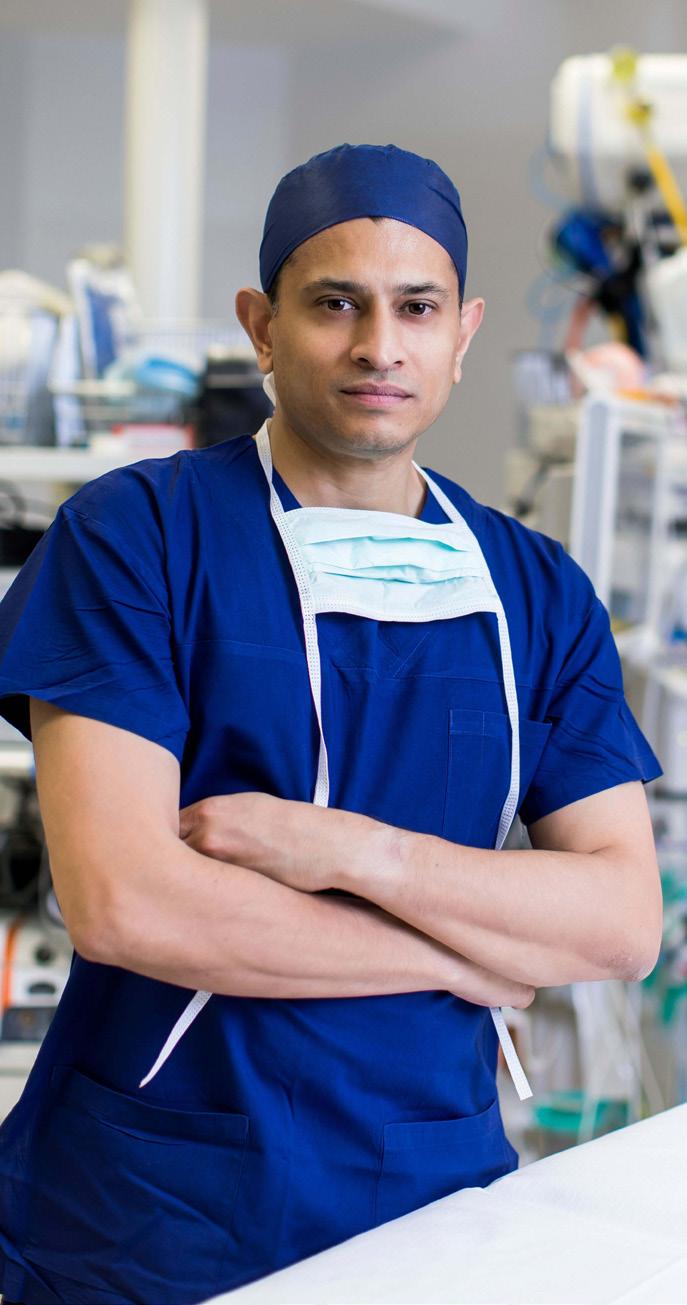
3 minute read
NECK AND BACK PAIN
Neck and back pain can range from mild, annoying aches to severe, disabling pain
While most spine pain occurs as a part of the normal degenerative ageing process-it can also be a warning sign of cancer, infection, autoimmune disease, or a structural problem causing pressure on the spinal cord/ nerves
Advertisement
WHY DOES THIS OCCUR?
Our spines are comprised of a number of joints around the spinal cord and nerves. As we age, changes occur as the joints wear out resulting in inflammatory processes such as osteoarthritis. The joints and tissues can also become overgrown and compress a neural structure, which is called spinal stenosis. Failure of the joints to hold the bones in position can result in slippage and deformity. These are common characteristics of conditions such as spondylolisthesis, kyphosis, or scoliosis.
WHAT SYMPTOMS CAN THESE DEGENERATIVE CHANGES CAUSE?
• Dull, burning, or sharp pain-which can be confined to a single spot or cover a large area.
• Arm/leg numbness or tingling
• Sharp, shooting pain that radiates from your neck and your arm.
• Sharp shooting pain that radiates from your lower back to your buttocks, and down your leg (sciatica)
• Stiffness in your neck or back
• Difficulties with walking and balance
• Difficulties with coordination
• Loss of bladder and bowel control, with weakness in both legs are important symptoms that require immediate medical attention.
HOW IS A DIAGNOSIS MADE?
You should see your general practitioner for a medical and physical exam. They may obtain a CT scan and /or an MRI scan to assess your spine. CT/MRI produces pictures of bones, joints, ligament, the spinal cord and spinal nerves. Sometimes other tests are needed such as bone scans and specialised x-rays.
HOW ARE BACK AND NECK PAIN TREATED?
If you experience back or neck pain it may simply improve with some rest. Over the counter medicines such as paracetamol or ibuprofen, may also help alleviate discomfort. Activity should be modified to avoid movement that exacerbates pain. Physiotherapy, acupuncture, and massage therapy are beneficial.
Low-impact exercise programs may improve range of motion, increase muscle strength, and improve flexibility and mobility, increase endurance, and improve pain. Weight loss and improving one’s core strength are also useful.
WHEN CAN A SURGEON HELP?
A surgeon can advise on further treatment if the above suggestions haven’t improved the pain and your quality of life.
Your surgeon can assess your imaging and recommend cortisone steroid injections that can alleviate some forms of neck, back, arm or leg pain.
An appropriate surgical operation can also significantly improve pain, mobility and quality of life.
WHAT DOES AN OPERATION INVOLVE?
Because symptoms, imaging findings and causative factors can vary significantly, a surgical procedure must be tailored for you. A traditional spine surgery procedure involves an incision along the backbone. The surgeon moves muscle and soft tissue aside to gain access to the bones of the spine and the spinal cord.
Minimally invasive techniques involve a smaller incision and special microsurgical instruments, through which the surgeon operates on the spine. Minimally invasive techniques may be able to shorten recovery time and reduce the risk of complications.
These approaches allow the surgeon to trim away overgrown bone, ligament and joint tissue to decompress the spinal cord and spinal nerve. Some operations (for example those that help control the conditions spinal stenosis or sciatica) employ a decompression technique and at times may also require a fusion. The latter involves a surgeon placing titanium screws and rods to stabilise the spine and cause adjacent vertebrae to fuse.
There are minimally invasive ways to perform this type of surgery, and can even encompass advanced technology such as GPS-like tracking systems and robotics. If performed for the right indications, surgery can be effective in 80-90% of patients.

What Happens After Surgery
Most patients are mobilised either on the same or following day of surgery, as early movement has been shown to be be beneficial.
You may be reviewed by a physiotherapist to provide advice on stretches, exercises and activities. Sometimes health professionals will design a rehabilitation program to meet your needs. The type of program will depend on the procedure you underwent and your level of mobility.
The goal of back and neck rehabilitation is to help you return to your highest level of fitness and independence and improve your overall quality of life.
Courtesy Dr Raj Reddy, MBBS, MS, FRACS
Dr Raj Reddy is a neurosurgeon with special interests in complex & minimally invasive spine surgery, paediatric neurosurgery, and brain tumour surgery.
Raj manages all neurosurgical conditions, both cranial and spinal. He has a special interest in spine surgery, with foci on minimally invasive techniques as well as complex reconstructive surgery. The focus of his cranial surgery is in the management of intracranial tumours, trauma , and craniofacial operations; both adults and paediatric patients

Suite 3, Level 7
Prince of Wales Private Hospital
Barker Street, Randwick NSW 2031
P (02) 9650 4132
E enquiries@brainspine.com.au
W. www.brainspine.com.au
Dr Peter Wilson is a specialist neurosurgeon with a focus on endoscopic skull base surgery, complex spinal surgery and cranial / spinal tumour surgery.

Peter is committed to maintaining the highest level of clinical and operative care of his patients, and is constantly striving to improve his practice by perpetually evolving in pace with the latest in medical advancements. His clinical interests include:
• Pituitary disease
• Trigeminal neuralgia / hemifacial spasm
• Spinal sagittal balance
• Benign and malignant brain tumours
Suite 3, Level 7
Prince of Wales Private Hospital
Barker Street, Randwick NSW 2031
P (02) 9650 4132
E enquiries@brainspine.com.au
W. www.brainspine.com.au








